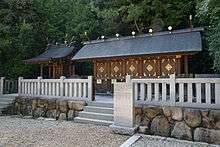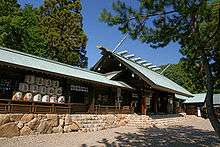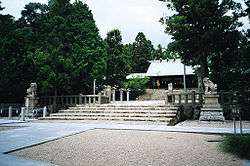Hirota Shrine
| Hirota Shrine 廣田神社 | |
|---|---|
|
Main hall | |
| Information | |
| Type | Grand Shrine, one of the Nijūnisha |
| Dedicated to | Amaterasu |
| Founded | 3rd century |
| Founder(s) | Empress Jingū |
| Address | 7-7 Taisha-chō, Nishinomiya, Hyōgo prefecture |
| Website |
www |
|
| |

Hirota Shrine (廣田神社 Hirota-jinja) is a Shinto shrine in Nishinomiya City, Hyōgo Prefecture, Japan. The town's name, "Nishinomiya", means "shrine of the west", and the town is named for Hirota Shrine.
Location
Hirota Shrine is near the bus stop for Hankyu Bus Co., Ltd. and Hanshin Bus Co., Ltd. "Hirota-Jinja-mae".
- Hankyu Bus Route 12 (for Kotoen)
- from JR West Nishinomiya Station (JR Kobe Line)
- Hankyu Bus Route 11 (for Kotoen)
- from Hanshin Nishinomiya Station (Main Line)
- Hanshin Bus Yamate Loop (counterclockwise, via Nishinomiya-Shiyakusho-mae)
History

Hirota Shrine is one of three shrines which, according to Nihon Shoki, a historical epic chronicle, was established by the Empress Jingū in the 3rd century. According to legend, Amaterasu, Goddess of the Sun, and arguably the most important kami in Shinto, spoke to the Empress and declared that she and the other gods of Japan must be enshrined in Hirota, Nagata, Ikuta, and Sumiyoshi. The Empress Consort did as commanded, and then achieved her political ambitions.
The shrine became the object of Imperial patronage during the early Heian period.[1] In 965, Emperor Murakami ordered that Imperial messengers were sent to report important events to the guardian kami of Japan. These heihaku were initially presented to 16 shrines;[2] and in 991, Emperor Ichijō added three more shrines to Murakami's list — including Hirota.[3]
According to the English-language brochure available at the shrine, in the 11th century, under Emperor Shirakawa, Hirota Shrine was designated as "one of the twenty-two honorable shrines in the nation" and given the title "Hirota Grand Shrine". Today it is the only grand shrine in Hyōgo. Others may use the term "taisha" (grand shrine), but they are without the Imperial distinction that sets Hirota Shrine apart.[4]
From 1871 through 1946, Matsunoo-taisha was officially designated one of the Kanpei-taisha (官幣大社), meaning that it stood in the first rank of government supported shrines.[5]
The shrine is also famous for its kobanomitsuba tsutsuji, azaleas with three small leaves.
Events
From the brochure "Hirota Shinto shrine (jinja)" available from the shrine.[4]
- January 1: Sai-tan-sai
- January 3: Gen-shi-sai
- January 1–3: Kai-un-sai
- January 18–19: Yaku-yoke-sai
- February 11: Ki-gen-sai
- February 17: Ki-nen-sai (Taisai)
- March 16: Rei-sai (Taisai)
- April 16: Haru matsuri (Spring festival)
- Late May: Hirota Ohtaue (Rice planting festival)
- June 30: Nagoshi no oohara eshiki
- July 16: Natsu matsuri (Summer festival)
- Late September: Neki-ho-sai
- October 16: Aki matsuri (Autumn festival)
- November 3: Mei-ji-sai
- November 23: Nii-name-sai (Taisai)
- December 23: Ten-chou-sai
- First day of each month: Tsuki hajime sai, Hatsu hokou-sai
- Sixteenth day of each month: Tsuki-name-sai
- Every morning: Asa-mi-ke-sai, Yuu-mi-ke-sai
See also
Notes
- ↑ Breen, John et al. (2000). Shinto in History: Ways of the Kami, pp. 74-75.
- ↑ Ponsonby-Fane, Richard. (1962). Studies in Shinto and Shrines, pp. 116-117.
- ↑ Ponsonby-Fane, Shrines, p. 118.
- 1 2 "Hirota Shinto shrine (jinja)" brochure available at the shrine (undated).
- ↑ Ponsonby-Fane, Richard. (1959). The Imperial House of Japan, pp. 124.
References
- Breen, John and Mark Teeuwen. (2000). Shinto in History: Ways of the Kami. Honolulu: University of Hawaii Press. ISBN 978-0-8248-2363-4
- Ponsonby-Fane, Richard. (1959). The Imperial House of Japan. Kyoto: Ponsonby Memorial Society. OCLC 194887
- _______________. (1962). Studies in Shinto and Shrines. Kyoto: Ponsonby Memorial Society. OCLC 399449
- Some of this article's contents are derived from the Hirota Jinja article on the Japanese Wikipedia.
| Wikimedia Commons has media related to Hirota Shrine. |
Coordinates: 34°45′10.7″N 135°20′23.9″E / 34.752972°N 135.339972°E
